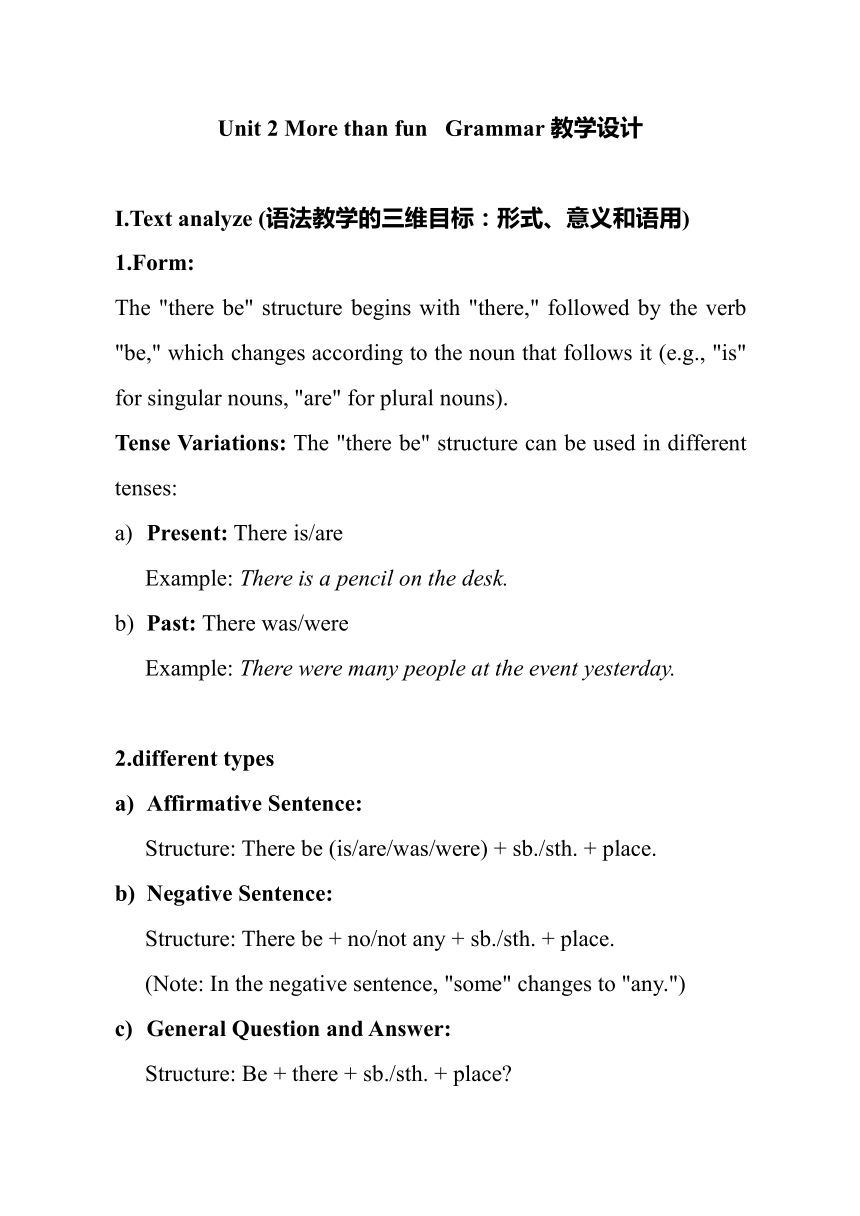
Unit 2 More than fun Grammar 教学设计 I.Text analyze (语法教学的三维目标:形式、意义和语用) 1.Form: The "there be" structure begins with "there," followed by the verb "be," which changes according to the noun that follows it (e.g., "is" for singular nouns, "are" for plural nouns). Tense Variations: The "there be" structure can be used in different tenses: Present: There is/are Example: There is a pencil on the desk. Past: There was/were Example: There were many people at the event yesterday. 2.different types Affirmative Sentence: Structure: There be (is/are/was/were) + sb./sth. + place. Negative Sentence: Structure: There be + no/not any + sb./sth. + place. (Note: In the negative sentence, "some" changes to "any.") General Question and Answer: Structure: Be + there + sb./sth. + place Answers: Yes, there is. / No, there isn’t. 3. Meaning: The structure indicates the existence or presence of something in a particular place or context. Example: There is a park near my house (indicating existence). 4. Usage (Context of Use): Introducing New Information: Used to introduce new topics or elements. Describing Locations or Positions: Common in providing the location of objects or people. Highlighting Quantities: Useful in indicating amounts or numbers. II.Teaching Objective: By the end of the lesson, students will be able to: 1.Use the "there be" structure to talk about things and people that exist in different places. 2.Make affirmative, negative, and question sentences with "there be" in both the present and past tenses. 3.Describe hobbies and interests using the "there be" structure III.Teaching procedures Stage 1 Grasp the structure and formation of there be and identify their usage in sentences. (presentation) Step 1: Observation and Identifying Common Features Begin by displaying sentences from the reading passage, such as: There is so much fun in music. There are many fans of them. Ask students to work in pairs to observe and discuss what these sentences have in common. Focus their attention on the structure: how "there" functions as a subject placeholder, followed by the verb "be" (which changes based on the noun that follows). Step 2: Finding Additional Sentences in the Passage Instruct students to find more examples of the "there be" structure within the reading passage. They might find sentences like: There is an art festival every autumn in my school. Step 3: Summarizing the Grammar Rules Lead a class discussion where students collectively summarize the grammar rules they observed. Cover points such as: (1)肯定句:There be(is/are/was/were)+ sb./sth.+地点。如: There are many people in the national park. 在国家公园有很多人。 (2)否定句:There be + no/not any + sb./sth.+地点。如: There aren't any people in the national park. 在国家公园没有很多人。(肯定句变否定句some变any) (3)一般疑问句及回答:Be + there + sb./sth.+地点?如: Is there an apple on the table 桌子上有苹果吗? (4)回答:Yes, there be. \No, there be not. There be 句型中be ... ...
~~ 您好,已阅读到文档的结尾了 ~~

